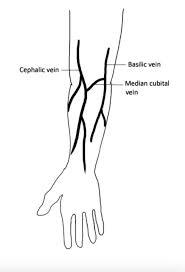According to the CLSI standard, a phlebotomist must attempt to locate which of the following veins on both arms before considering other veins?
Median cubital vein
Basilic vein
Cephalic vein
Veins on the underside of the wrist
The Correct Answer is A
Choice A Reason:
The median cubital vein is often the first choice for venipuncture due to its size and accessibility. It is located in the antecubital fossa and is usually well anchored by surrounding tissues, which makes it less likely to roll during needle insertion. This vein is also less painful for patients when punctured due to its location and the type of surrounding tissue.
Choice B Reason:
The basilic vein is another option for venipuncture, but it is not typically the first choice. It is located on the medial aspect (inner side) of the arm and is more prone to rolling and injury because it is not as well anchored as the median cubital vein. Additionally, the basilic vein is located near nerves and arteries, which increases the risk of complications during venipuncture.
Choice C Reason:
The cephalic vein runs along the lateral aspect (outer side) of the arm and can be used for venipuncture. However, it is often more difficult to locate and has a tendency to roll, which can make venipuncture more challenging. It is usually considered after the median cubital vein.
Choice D Reason:
Veins on the underside of the wrist should generally be avoided for routine venipuncture because they are often smaller, can be more painful due to the proximity to nerves and tendons, and have a higher risk of complications. These veins are considered only when other sites are not available or are unsuitable for venipuncture.

Nursing Test Bank
Naxlex Comprehensive Predictor Exams
Related Questions
Correct Answer is D
Explanation
Choice A reason:
While maintaining compliance with Clinical Laboratory Improvement Amendments (CLIA) standards is important, it is not the primary reason for explaining the venipuncture procedure to the patient. CLIA standards primarily deal with laboratory testing and do not specifically require the explanation of procedures to patients.
Choice B reason:
Evaluating the patient's understanding is a beneficial practice as it ensures that the patient is informed and can participate in their own care. However, it is not the primary legal or ethical requirement for explaining the procedure.
Choice C reason:
Maintaining compliance with Occupational Safety and Health Administration (OSHA) standards is crucial for ensuring the safety of both the healthcare provider and the patient. OSHA standards require that certain safety protocols be followed, but they do not specifically mandate that the procedure be explained to the patient for the purpose of obtaining consent.
Choice D reason:
Obtaining the patient's consent is the primary reason a phlebotomist should explain the procedure prior to venipuncture. Informed consent is a fundamental ethical and legal principle in healthcare. It involves informing the patient about the procedure, its risks, benefits, and alternatives, and ensuring that the patient understands this information before agreeing to proceed. This process respects the patient's autonomy and right to make decisions about their own healthcare.
Correct Answer is B
Explanation
Choice A reason:
Wearing gloves is an important step in preventing the spread of infection, but it is not the first step. Gloves provide a barrier between the phlebotomist's hands and the patient, which can help prevent the transmission of pathogens. However, gloves can still become contaminated, and if hand hygiene is not performed before donning gloves, pathogens can be transmitted when gloves are changed or removed.
Choice B reason:
Hand hygiene is widely recognized as the single most important practice in preventing the spread of infections. It is the first line of defense against the transmission of infectious agents. Washing hands with antimicrobial soap and water mechanically removes pathogens, and the antimicrobial agents in the soap can kill or inhibit the growth of microorganisms. This step is crucial before any patient contact, especially before invasive procedures like venipuncture.
Choice C reason:
Applying antiseptic to the puncture sites prior to venipuncture is a critical step in the prevention of infection at the site of the blood draw. This practice is essential for eliminating skin flora that could potentially enter the bloodstream during venipuncture. However, this is not the first step, as effective hand hygiene should precede any patient contact or procedure.
Choice D reason:
Decontaminating equipment before use is a necessary step to ensure that no infectious agents are transmitted via medical instruments. This includes cleaning and sterilizing equipment that comes into direct contact with the patient. While this is a vital part of infection control, it follows hand hygiene in the sequence of steps a phlebotomist should take.
Whether you are a student looking to ace your exams or a practicing nurse seeking to enhance your expertise , our nursing education contents will empower you with the confidence and competence to make a difference in the lives of patients and become a respected leader in the healthcare field.
Visit Naxlex, invest in your future and unlock endless possibilities with our unparalleled nursing education contents today
Report Wrong Answer on the Current Question
Do you disagree with the answer? If yes, what is your expected answer? Explain.
Kindly be descriptive with the issue you are facing.
